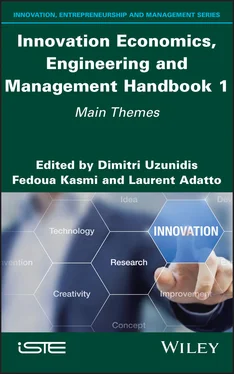This delimitation and specialization of innovation has been contested by a double movement. On one hand, innovation has become an imperative for all companies subject to ambiguous, uncertain, complex and volatile environments (Bennis and Nanus 1985). These conditions imply greater organizational flexibility, with faster rhythms in developing products for the markets. On the other hand, innovation has been progressively democratized (von Hippel 2005) with the idea that innovation is no longer the producer’s activity of creation and also that of users with the simpler and more accessible use of information technology, and more recently, of the 3D printer. This openness to innovation is defended by the proponents of open innovation (Chesbrough 2003, 2006; von Hippel 2005). They point to a paradigm shift in innovation management from a rather closed mode to a more open mode, at both organizational and individual levels. This approach calls the more internalized model of innovation into question, where spaces are more closed and specific to the organization, through a more externalized model with more open spaces, less centered around an organization linked to communities or collaborative movements (Bohas et al . 2017).
This greater porosity still raises questions about how to manage innovation spaces. While innovation has never been a closed phenomenon, these contemporary models refer to a less linear, more dynamic or even more turbulent approach. In this context, how should the organization manage these spaces? Is it necessary to delimit or widen the spaces for innovation? What about the configuration of these spaces?
2.2.1. Delimiting and/or expanding organizational spaces
A first “centripetal” perspective is that of a delimitation of innovation spaces. Whether it is a simple idea or an invention as a starting point, its development presupposes knowledge between actors who can engage in rich and rapid exchanges, connections that make it possible to develop expert knowledge, whose cross-fertilization would promote in-depth learning (Camagni 1991; Maskell and Mamberg 1999). As proximity theorists defend (Torre and Gilly 2000), proximities (physical, social, cognitive, etc.) favor these types of virtuous interactions, which explain the existence of innovation departments, learning communities, innovation networks, clusters or innovation ecosystems where strong links are crucial. Of course, these networks where expert knowledge circulates are not completely closed, as it is absolutely essential that they are constantly irrigated with new knowledge to give rise to new ideas and creativity (Cohendet and Llerena 1997). Nevertheless, the underlying assumption is that innovation in these spaces is related to absorptive capacity (Cohen and Levinthal 1990) – an ability of the organization to identify the value of new information, to assimilate it and apply it for commercial purposes. This capacity depends on knowledge and skills already acquired by the firm’s actors in their past exploration and exploitation of technologies and markets. In fact, there is a form of path dependency (Antonelli 1997; Belussi and Sedita 2009) guiding new explorations of new ideas to extend existing knowledge bases, in order to develop innovation. These pathways allow for faster progress in the learning process to innovate.
A second “centrifugal” perspective is that of widening the space for innovation by opening up organizational boundaries. Organizational boundaries tend to lock individuals and groups into cognitions that are too similar, and this is reinforced by social reproduction mechanisms (Bourdieu and Passeron 1970), which can induce, at a more macro level, paradigms that lock the organization into a dominant logic that can restrict its capacity to innovate (Prahalad and Bettis 1995; Kor and Mesko 2013). This lack of openness would explain the inability of certain large firms (such as Kodak, Ericsson and Motorola) to innovate when they had all the knowledge and human capital necessary to do so. Consequently, this perspective underscores the importance of de-embedding relationships and interactions for the contribution of new ideas and knowledge, particularly through the strength of weak ties (Granovetter 1985). The hypothesis here is that innovation depends on a combined capacity to identify, capture and integrate knowledge or resources for innovation into the established organization (Teece et al . 1997). In contrast to the absorptive capacity approach, it is less the stock than the flow which guides innovation paths.
However, too much openness can be counterproductive for two reasons. On one hand, firms run the risk of rapid imitation by competitors, hence the importance of forms of protection for their intellectual property. On the other hand, a multiplication of interaction spaces can end up generating too much noise, too much information that is difficult to combine, leading to misunderstanding and dispersion in the end. In fact, openness does not need to be complete for an organization. It is more a question of creating porosity through specific connections from internal space to external space, by leveraging technologies in the form of licensing or spin-offs, and also from external space to internal space by including new technologies from other networks (Chesbrough 2012).
However, these two perspectives are not incompatible. A balanced approach allows us to understand that innovation needs both centripetal and centrifugal movements to advance more quickly and efficiently. In the beginning, innovation may need some form of protection, even though this incubation does not take place in a vacuum. The metaphor of the baby as a fetus can be enlightening here. The fragility of the fetus presupposes its protection in the womb. Although isolated and nourished in the amniotic fluid, the baby remains in contact with the world. After birth, interaction and openness become more fundamental. Innovation needs porosity and connectivity in a balanced way at different times and in different contexts. Moreover, business incubators have two functions of protection and intermediation, as Amezcua et al . (2013) have pointed out. Beyond the spaces dedicated to innovation, this duality is inherent to any organization, which like a living organism, contracts and expands, explores and exploits, opens and closes, specializes and diversifies, etc. Thinking of innovation as any complex phenomenon implies not opposing opposites but thinking of them in a complementary relationship (Morin 2005).
Thus, rather than two opposing movements, they are two complementary movements: (1) a protective delimitation movement to concentrate resources, develop expertise and make sense (Weick et al . 2005) in a given space to allow innovation to emerge and (2) a reticular enlargement movement to develop resources, nourish expertise and make sense (Gioia and Chittipeddi 1991) to allow innovation to unfold. These movements can be understood as forms of coupling (Weick 1976) inherent in organizations and systems. Sometimes, an organization decouples itself from its environment in order to constitute and preserve a form of integrity. Sometimes, it couples with its environment to develop and assert a form of legitimacy (Pache and Santos 2013). This complementarity argues for a conception of change and innovation as permanent organizational processes (Tsoukas and Chia 2002), a continuous process of perpetual organizational emergence.
2.2.2. Developing links within and outside the spaces
The classic players in innovation are the designated specialists: R&D engineers, designers, product developers, actors of change in production processes, etc. By broadening the perimeter or space for innovation, the innovation players are also multiplied. Thus, anyone involved in the design of new products and processes becomes an innovator (Dyer et al . 2009), as well as anyone who transforms them into opportunities (Shane and Venkataraman 2000) in organized forms (Gartner 2017). In recent years, we have observed a democratization of these two roles that were previously specialized and reserved for a minority (Audretsch 2007). This democratization goes hand in hand with the idea that innovation is a permanent process of an organization’s evolution, which is circumscribed in time and delimited within certain organizational boundaries. It seems to accelerate with the possibility of everyone participating and contributing systematically to innovation in the firm, thanks to the potential of information and communication technologies, opening up a networked society (Castells 2000).
Читать дальше












